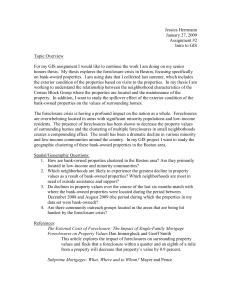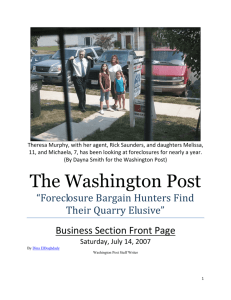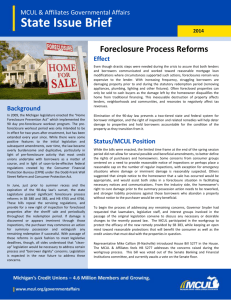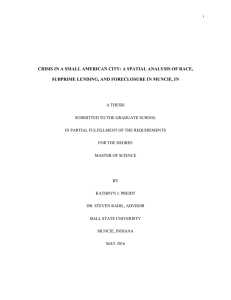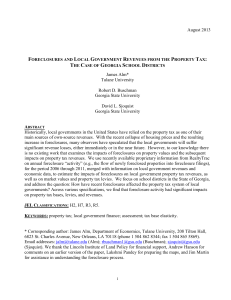of Foreclosures in Massachusetts Communities of Color
advertisement
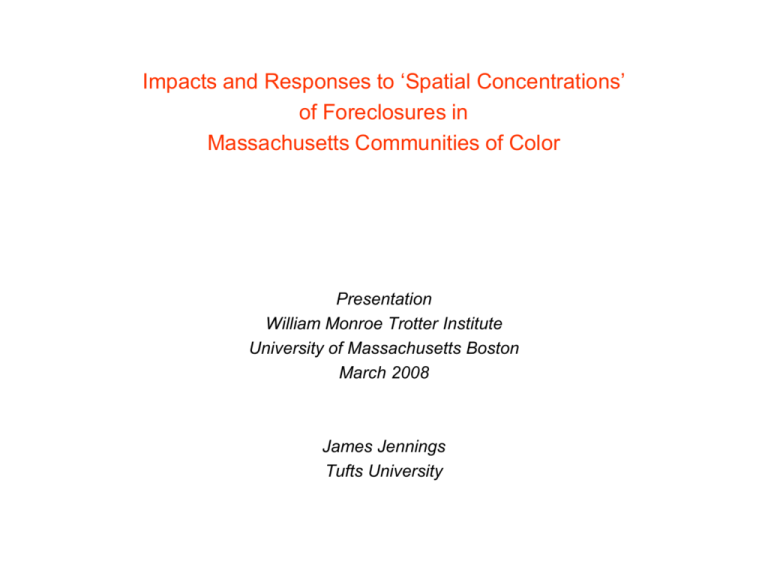
Impacts and Responses to ‘Spatial Concentrations’ of Foreclosures in Massachusetts Communities of Color Presentation William Monroe Trotter Institute University of Massachusetts Boston March 2008 James Jennings Tufts University National responses Federal Reserve Bank - lowering interest rates - “prudent loan workouts” (Report to US Congress, 2/27/08) US Congress: S(2636): “Foreclosure Prevention Act of 2008” would allow homeowners to file for bankruptcy without losing their homes HR 1289: The “Community Reinvestment Act Modernization Act of 2007” would expand CRA regulations to a range of lending institutions Massachusetts: An Act Protecting and Preserving Home Ownership (Chapter 206 of the Acts of 2007) • contact borrowers before resets; • long-term loan modifications; • mortgage loan modification if consumers qualify; • allow pre-foreclosure sale; • allow deed in lieu of foreclosure • requiring housing counseling for secondary market customers Two levels of challenges: • Individual and Families • Neighborhoods with spatial concentrations of foreclosures Spatial concentrations of foreclosures in Massachusetts communities of color 1) factors leading to spatial concentrations of foreclosures? 2) impacts of spatial concentrations of foreclosures on lowincome neighborhoods? 3) potential community development guideposts for strategies in response to spatial concentrations of foreclosures? Factors leading to spatial concentrations of foreclosures - De-regulatory climate - Subprime lending -Predatory and fraudulent lending De-regulatory climate * Financial Institutions Reform, Recovery, and Enforcement Act (1989) * Financial Services Modernization Act (1999) weakens the Glass-Seagall Act (1933) under Roosevelt’s New Deal (separates commercial from investment banking due to conflicts of interest) weakens disclosure requirements weakens Federal Reserve Bank’s restriction on the formation of financial holding companies CRA regulatory relief for small banks (less than $250 million): a satisfactory rating would mean relief from evaluation for a period of 5 years * Globalization of US mortgage market (securization) Subprime lending (adjustable rate mortgages -ARMs) NOTE(!): * More than one quarter (26.0%) of all holders of subprime adjustable loans in New England may qualify for prime loans (!!) -Eric S Rosengren, Subprime Mortgage Problems…Federal Reserve Bank of Boston, December 2007 * Wall Street Journal (December 3, 2007): 61% of subprime loans originated in 2006 went to people with very high credit scores Racial / ethnic element?..... In 2005: African-American conventional borrowers: 53% received subprime loan Latino conventional borrowers: 37.8% White conventional borrowers: 21.6% Asian conventional borrowers: 13.5% A.J. Fishbein and P. Woodall, Subprime Locations: Patterns of Disparity… (Consumer Federation of American, 2006) Geographic J. Campen, Mortgage Lending to Traditionally Underserved Borrowers and Neighborhoods in Boston, Greater Boston and Massachusetts, 2006 (Mauricio Gaston Institute, February 2008) Predatory and fraudulent lending targeting and marketing high-priced loans to households based on criteria unrelated to credit-worthiness, such as race/ethnicity; language; age; or gender (see, Carr and Kolluri, Predatory Lending: An Overview, 2001) A. Rivera, et al., Foreclosed: State of the Dream 2008 (United for a Fair Economy, 2008) ACORN, Foreclosure Exposure 2: The Cost to our Cities and Neighborhoods (2007) Low-income and working-class neighborhoods experiencing ‘spatial concentrations” of foreclosures: two examples… Example 1 Roxbury, South Dorchester, North Dorchester, and Mattapan: represent 32% of Boston’s total population, but 60% of all foreclosure petitions in the city in 2007 • 182,911 persons: Black(53%); White(21%); Latino(18%); and, Asian(7%) • 31% of occupied housing units are owner-occupied • 33% of all households have estimated income of less than $25,000 • Estimated Per Capita Income is $17,971(2006) • Approximately one quarter (28%) of all persons are 17 years or younger Example 2 The Arlington Neighborhood in Lawrence represented 13.4% of city’s total population, but 35% of all foreclosure petitions in 2006 • 10,764 persons (84% are Latino/a) • 73% of all persons 5 years+, speak Spanish at home • Homeownership: 16.3% of the 3,589 housing units are owner-occupied • More than half (54.2%) of all HH earned less than $25,000 income • Estimated Per Capita Income: $11,162 Spatial concentrations of foreclosures endangers, weakens neighborhoods in a number of ways: • Reduces property values • Contributes to overcrowding in housing • Contributes to residential (both rental and owner-occupied) instability • Endangers small businesses and micro-enterprises • Reduces disposable income in a community • Reduces tax revenue for local government • Raises the anxiety level of children and young people…? • Arson…? Recommendations for cities and communities 1) New civic discourse about the meaning of ‘homeownership’ - cooperative-owned housing? - community land trusts? BR Housing in Lawrence, Massachusetts DSNI in Roxbury, Massachusetts 2) A wide range of community-based organizations and the faith-based sector, and local businesses must become more engaged with this community-wide challenge (See, Rick Cohen, “Foreclosed, but not forewarned: subprime mess will put pressure on charities” The Non-profit Times, February 1, 2008) 3) Foundation sector: more focus on “place-based” / neighborhood empowerment initiatives? working with smaller, community-based nonprofits? community building and organizing? 4) Community-based’ financial literacy as an essential component of anti-foreclosure strategies: raising ‘financial literacy’ on a community-wide level The Foreclosure Watch Zone initiative in Lawrence, Massachusetts In November 2007, the Lawrence City Council passed a resolution declaring the Arlington Neighborhood, a ‘foreclosure watch zone’. (see, Arlington Community Trabajando CDC in Lawrence, Massachusetts) a) increases potential for outreach and impact of strategies; b) enhances quality of collaboration among community sectors c) greater opportunities to share findings with a range of community sectors
